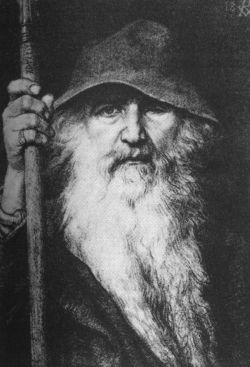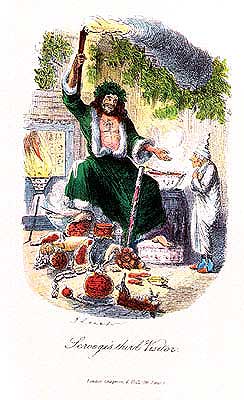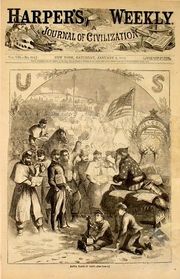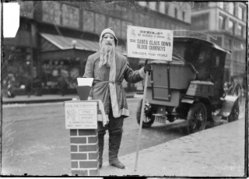The modern Santa Claus is thought to be a composite character made up from the merging of quite separate figures.
Contents |
Ancient Christian origins
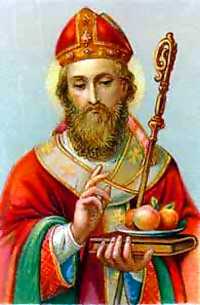
The first of these is Saint Nicholas of Myra, a 4th century CE Christian bishop of Myra in Lycia, a province of Byzantine Anatolia, now in Turkey. Nicholas was famous for his generous gifts to the poor, in particular presenting the three impoverished daughters of a pious Christian with dowries so that they would not have to become prostitutes. He was born at Patara, province of Lycia, Asia Minor. He was very religious from an early age and devoted his life entirely to Christianity. In Europe (more precisely the Netherlands, Belgium, Austria and Germany) he is still portrayed as a bearded bishop in canonical robes. The relics of St. Nicholas were transported to Bari in southern Italy by some enterprising Italian merchants; a basilica was constructed in 1087 to house them and the area became a pilgrimage site for the devout. Saint Nicholas became revered by many as the patron saint of seamen, merchants, archers, children, prostitutes, pharmacists, lawyers, pawnbrokers, prisoners, the city of Amsterdam and of Russia. In Greece, Saint Nicholas is sometimes substituted for Saint Basil (Agios Vasilis in Greek), a 4th century AD bishop from Caesarea. Also, a few villages in West Flanders, Belgium, celebrate a near identical figure, Sint-Maarten (Saint Martin of Tours).[1]
Germanic folklore
Prior to the Germanic peoples' conversion to Christianity, Germanic folklore contained stories about the god Odin (Wodan), who would each year, at Yule, have a great hunting party accompanied by his fellow gods and the fallen warriors residing in his realm. Children would place their boots, filled with carrots, straw or sugar, near the chimney for Odin's flying horse, Sleipnir, to eat. Odin would then reward those children for their kindness by replacing Sleipnir's food with gifts or candy [Siefker, chap. 9, esp. 171-173]. This practice survived in Germany, Belgium and the Netherlands after the adoption of Christianity and became associated with Saint Nicholas. Children still place their straw filled shoes at the chimney every winter night, and Saint Nicholas (who, unlike Santa, is still riding a horse) rewards them with candy and gifts. Odin's appearance was often similar to that of Saint Nicholas, being depicted as an old, mysterious man with a beard. (Other features, like the absence of one eye, are not found in Saint Nicholas.) This practice in turn came to America via the Dutch colony of New Amsterdam prior to the British seizure in the 17th century, and evolved into the hanging of socks or stockings at the fireplace.
Another early folk tale, originating among the Germanic tribes, tells of a holy man (sometimes Saint Nicholas), and a demon (sometimes the Devil, Krampus, or a troll). The story states that the land was terrorized by a monster who at night would slither down the chimneys and slaughter children (disembowelling them or stuffing them up the flue, or keeping them in a sack to eat later). The holy man sought out the demon, and tricked it with blessed or magical shackles (in some versions the same shackles that imprisoned Christ prior to the crucifixion, in other versions the shackles were those used to hold St. Peter or Paul of Tarsus); the demon was trapped and forced to obey the saint's orders. The saint ordered him to go to each house and make amends, by delivering gifts to the children. Depending on the version, the saint either made the demon fulfil this task every year, or the demon was so disgusted by the act of good will that it chose to be sent back to Hell.
Yet other versions have the demon reform under the saint's orders, and go on to recruit other elves and imps into helping him, thus becoming Santa Claus. In an alternate Dutch version, the saint is aided by slaves, commonly typified as Zwarte Piet ("Black Peter"). Some tales depict Zwarte Piet beating bad children with a rod or even taking them to Spain (formerly ruled by the Moors) in a sack. Though some people find the tradition of zwarte piet discriminating, because this would refer to the fact that Saint Nicolas would have negro slaves to do the work for him in the busy days before pakjesavond (boxing day); according to those people this would promote and teach hate and racism to young children. This story is only partially true, zwarte piet started his "career" as a slave indeed, but not in service of Saint Nicolas. In fact Saint Nicolas was the one who bought zwarte piet from a slavetrader, only to set him free. Grateful as zwarte piet was however, he didn't have anywhere to go as he was separated from his relatives and had no job to support himself. Saint Nicolas offered him a job (in some (fictional) stories this job was listing all the kids their wishes for boxing day, other stories say that zwarte piet was keeping track of all the bad children, in order to capture them in a sack and take them to Spain... as Spain would be the home country of Sinterklaas). In recent decenia this story has been changed to normal servants who have black faces because they climb through chimney's and get blackened by the sooth from the fires. Black Peters are to Saint Nicolas, what the elves are to santa clause... in tradtion the Saint has a Peter for every function.. for example: Navigation Peters to navigate the steamboat from Spain to Holland, acrobatic Peters for climbing up the roofs to stuff presents through the chimney, or to climb through themselves etc. etc. And through the years a lot of stories were added, mostly made up by parents to keep their childrens faith in Saint Nicolas (often called "De goede Sint" (the good/friendly Saint),and to prevent their children from misbehaviour, as they are told that good behaviour would be rewarded on boxing-day.
Another form of the above tale in Germany is of the Pelznickel or Belsnickle ("Furry Nicholas") who visited naughty children in their sleep. The name originated from the fact that the person appeared to be a huge beast since he was covered from head to toe in furs.
Modern origins
Pre-modern representations of the gift-giver from church history and folklore merged with the British character Father Christmas to create the character known to Britons and Americans as Santa Claus. Father Christmas dates back at least as far as the 17th century in Britain, and pictures of him survive from that era, portraying him as a well-nourished bearded man dressed in a long, green, fur-lined robe. He typified the spirit of good cheer at Christmas, and was reflected in the "Ghost of Christmas Present" in Charles Dickens's A Christmas Carol.
The name Santa Claus is derived from Sinterklaas, the Dutch name for the mythical character based on St. Nicholas. He is also known there by the name of Sint Nicolaas which explains the use of the two fairly dissimilar names Santa Claus and Saint Nicholas or St. Nick.
Sinterklaas wears clothing similar to a bishop's. He wears a red miter (a liturgical headdress worn by bishops and abbots) with a 'golden' cross and carries a bishop's staff. The connection with the original bishop of Myra is still evident here. He rides a white horse over rooftops and his helpers climb down chimneys to deposit gifts (sometimes in children's shoes by the fireplace). Sinterklaas arrives from Spain on a steamboat and is accompanied by 'Zwarte Piet', his negroid helpers.
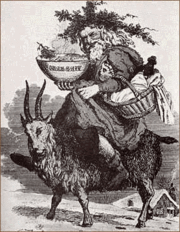
Presents given during this feast are often accompanied by poems, sometimes fairly basic, sometimes quite elaborate pieces of art that mock events in the past year relating to the recipient (who is thus at the receiving end in more than one sense). The gifts themselves may be just an excuse for the wrapping, which can also be quite elaborate. The more serious gifts may be reserved for the next morning. Since the giving of presents is Sinterklaas's job presents are traditionally not given at Christmas in the Netherlands, but commercialism is starting to tap into this market.
In other countries, the figure of Saint Nicholas was also blended with local folklore. As an example of the still surviving pagan imagery, in Nordic countries there was the Yule Goatjulbock, Norwegian "julebukk", Finnish joulupukki), a somewhat startling figure with horns which delivered the presents on Christmas Eve. A straw goat is still a common Christmas decoration in Sweden, Norway and Finland. In the 1840's, the farm gnome in Nordic folklore started to deliver the Christmas presents in Denmark, but was then called the "Julenisse", dressed in gray clothes and a red hat. By the end of the 19th century this tradition had also spread to Norway and Sweden (where the "nisse" is called Tomte), replacing the Yule Goat. The same thing happened in Finland, but there the more human figure retained the Yule Goat name..
American origins
In the British colonies of North America and later the United States, British and Dutch versions of the gift-giver merged further. For example, in Washington Irving's History of New York, Sinterklaas was Americanized into "Santa Claus" but lost his bishop's apparel, and was at first pictured as a thick-bellied Dutch sailor with a pipe in a green winter coat. Irving's book was a lampoon of the Dutch culture of New York, and much of this portrait is his joking invention.
Modern ideas of Santa Claus seemingly became canon after the publication of the poem "A Visit From St. Nicholas" (better known today as "The Night Before Christmas") in the Troy, New York, Sentinel on December 23, 1823. The poem is ascribed to Clement Clarke Moore, although there is some question as to his authorship. In this poem Santa is established as a heavyset individual with eight reindeer (who are named for the first time). Santa Claus later appeared in various colored costumes as he gradually became amalgamated with the figure of Father Christmas, but red soon became popular after he appeared wearing such on an 1885 Christmas card. Still, one of the first artists to capture Santa Claus's image as we know him today was Thomas Nast, an American cartoonist of the 19th century. In 1863, a picture of Santa illustrated by Nast appeared in Harper's Weekly (it is believed the inspiration for his image came from the Pelznickle). Another popularization was The Life and Adventures of Santa Claus, a 1902 biography (of sorts) from youth to old age by L. Frank Baum, author of The Wonderful Wizard of Oz. Much of Santa Claus's mythos was not set in stone at the time, and Baum almost completely ignored the poem, giving his "Neclaus" (Necile's Little One) a wide variety of immortal support (Fairies, Wood Nymphs (including his adoptive mother, Necile), Knooks, Ryls, Sound Imps, Light Elves, Sleep Fays, Gnomes, Water Spirits, Wind Demons, and the lioness Shiegra), a home in the Laughing Valley of Hohaho, and ten reindeer that were not domesticated at all (and had different names from the poem), but whom the Knooks let out of the forest one day each year (and they could not fly, but leapt in enormous, flight-like bounds). Most importantly, Baum revealed that Claus's immortality was earned, much like his title ("Santa"), decided by a vote of those naturally immortal. True to his historic origins as a bishop, Baum's Santa Claus never married. Baum also established Claus's motives: a happy childhood among immortals. When Ak, Master Woodsman of the World, exposes him to the misery and poverty of children in the outside world, he strives to find a way to bring joy into the lives of all children, and eventually invents toys as a principal means.
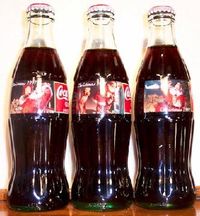
Images of Santa Claus were further cemented through Haddon Sundblom's depiction of him for The Coca-Cola Company's Christmas advertising. The popularity of the image spawned urban legends that Santa Claus was in fact invented by Coca-Cola. Nevertheless, Santa Claus and Coca-Cola have been closely associated.[2] The image of Santa Claus as a benevolent character became reinforced with its association with charity and philanthropy, particularly organizations such as the Salvation Army. Volunteers dressed as Santa Claus typically became part of fundraising drives to aid needy families at Christmas time.
Other possible originss
See also
Categories: Santa Claus

